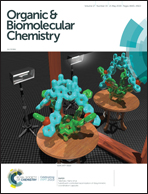Melleolides impact fungal translation via elongation factor 2†
Abstract
Melleolides from the honey mushroom Armillaria mellea represent a structurally diverse group of polyketide-sesquiterpene hybrids. Among various bioactivites, melleolides show antifungal effects against Aspergillus and other fungi. This bioactivity depends on a Δ2,4-double bond present in dihydroarmillylorsellinate (DAO) or arnamial, for example. Yet, the mode of action of Δ2,4-unsaturated, antifungal melleolides has been unknown. Here, we report on the molecular target of DAO in the fungus Aspergillus nidulans. Using a combination of synthetic chemistry to create a DAO-labelled probe, protein pulldown assays, MALDI-TOF-based peptide analysis and western blotting, we identify the eukaryotic translation elongation factor 2 (eEF2) as a binding partner of DAO. We confirm the inhibition of protein biosynthesis in vivo with an engineered A. nidulans strain producing the red fluorescent protein mCherry. Our work suggests a binding site dissimilar from that of the protein biosynthesis inhibitor sordarin, and highlights translational elongation as a valid antifungal drug target.

- This article is part of the themed collection: Chemical Biology in OBC


 Please wait while we load your content...
Please wait while we load your content...